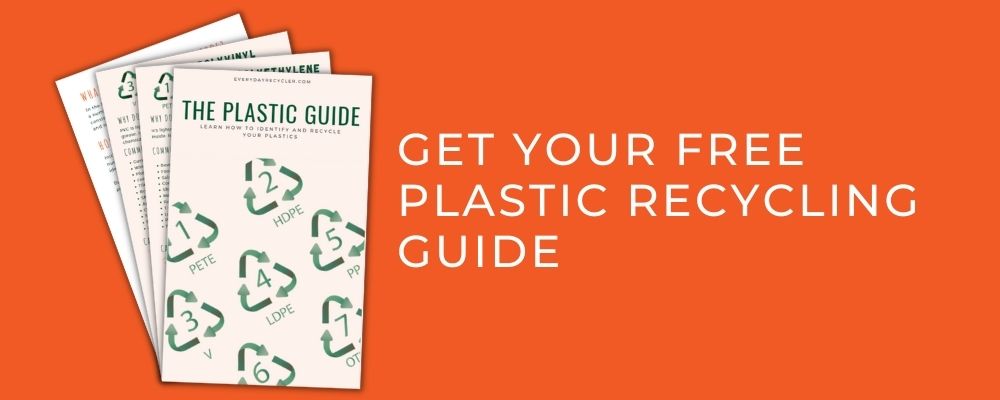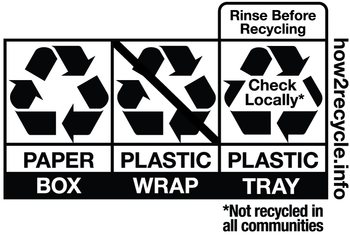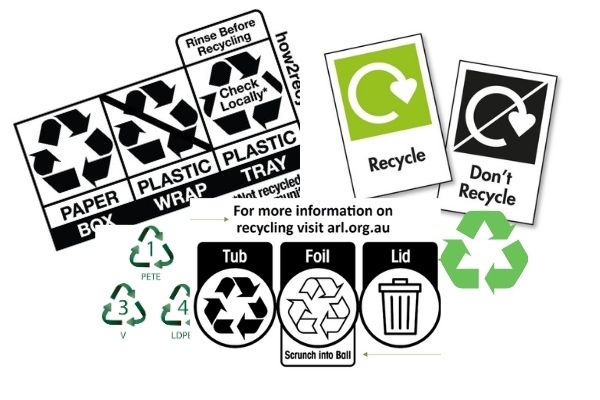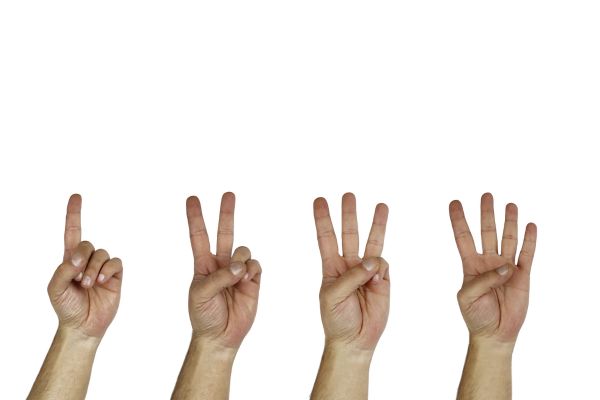We all want to do our best and recycle more but it can be hard to figure out how. With so many different recycling symbols and meanings on product packaging, it’s no wonder we often find ourselves confused.
But don’t get discouraged. The good news is there are lots of people working on making recycling easier for you and me. In this article, we explain the new recycle symbols that are spreading across the packaging world and show you how to use them. Plus we will let you know what other tools can help you be a better recycler.
Let’s see if together we can increase recycling rates and help make recycling work.
Quick Navigation
What Tools Are Available
There are a number of tools that are available to help us to determine whether an item is recyclable or not.
These tools include:
- Recycling Symbols on packaging
- Plastic Resin Codes on packaging
- Council and Government recycling guides
- Online resources
- Company recycling guides or programs
Below we provide some information on each of these tools and how to use them.

Recycling Symbols and Meanings
The most exciting tools available are the new recycling symbols and meanings that have been implemented in several countries in the last few years. These updated systems aim to help us recycle better and to reduce overall contamination.
They do this by providing simple answers to recyclability with clear actions. There is a separate label provided for each of the different types of packaging and short tips on how to recycle each type.
For example, if you have a cereal packet the recycling label will tell you what you can do with each different component of the packaging. The cardboard box goes in your recycling bin and the bag inside is returned to the store in the soft packaging recycling.
The problem with some of the older systems is that they are sometimes vague and often only address one part of the packaging. Leaving you and me still a little confused. The oversimplified nature of the information, e.g. placing the recycling green arrow symbol on the package, can also lead to a lot more contamination.
These new labels or symbols are in many countries a voluntary programme. Fortunately, there is good progress and a lot of companies have signed up to these systems including some biggies like Walmart in the USA, Marks and Spencers in the UK, and Woolworths in Australia and South Africa.
Below we take a look at a few of these systems and provide examples of the format and links you can use to get more familiar with them.
United States and Canada Symbols
In the United States, the How2Recycle label has been created to address the variation and inaccuracy of recyclability claims on packaging.
The label contains multiple parts. Firstly a clear icon to tell you if the item can be recycled or not. There are four categories “Widely Recycled”, “Check Locally”, “Not Yet Recycled”, and “Store Drop-Off.
At the bottom is a description of the type of material, e.g. plastic or paper followed by a description of the part of the packaging being described, e.g. tray, box or film.
Above each label is a short instruction on how to prepare the item for recycling. Examples include “empty & replace cap”, “remove labelling before recycling” or “rinse before recycling”
In the example below the item is a plastic bottle that can be recycled as long as you empty the bottle and put the cap back on.

Find out more: How2Recycle labeling system
United Kingdom
The UK’s On-Pack Recycling Label (OPRL) mission is to deliver a simple, consistent and UK-wide recycling messages. Ultimately, they want consumers to be able to recycle right and more often. Their message is delivered through their On-Pack Recycling Label.
It’s a binary labelling system, with two simple labels “Recycle” and “Don’t Recycle”. The Yes/No labels are designed to assist consumers in getting a split second answer to their recycling questions. The Recycle/Don’t Recycle label is provided for each part of the packaging. For example, the tray, carton, cardboard sleeve, the foil will all have their own Recycle/Don’t Recycle label.
The labels also include some basic instructions to help ensure the greatest amount of recycling and minimal contamination. They include things like rinse, lid-on, remove the sleeve, or flatten.

The “Recycle” and “Don’t Recycle” categorisation is determined by reviewing data from the majority of the collection programs throughout the UK. It’s not a perfect system and if you are keen to recycle as much as you can then you might need to do your own research. If your local area is ahead of the rest in recycling services you will want to check and not just rely on the label. If you are unsure check with your local authority, here is the RecycleNow Locator.
There’s a lot riding on the update of their logo with the UK aiming for 70% of plastic packaging effectively recycled by 2025. UK recycling is currently only at 45% so there is a bit of a way to go. https://resource.co/article/oprl-move-yesno-recycling-advice
Check the RecycleNow website for more information and a list of complimentary labels
Find out more: RecycleNow Symbols Explained
Australia and New Zealand
The Australian Packaging Covenant developed the Australasian Recycling Label (ARL) in response to the confusion over rules around recycling. It was launched in 2018 and aims to help consumers understand how to recycle.
The labelling breaks the information down to the different components that make up the packaging and provides information on how to dispose of each type of material. The ultimate goal is to help all of us recycle better and to reduce overall contamination.

For package designers, the ARL works closely with businesses to develop their labelling and assess the recyclability of their packaging. This is completed using an online tool called the Packaging Recyclability Evaluation Portal (PREP). It looks at many factors in the design of the packaging including the shape, size, weight, the inks and adhesives used and colours and dyes.
Over 200 businesses have signed up for the ARL program already and support for the program continues to grow. Keep your eye out for the labelling and get to know it better using these links.
Find out more: Australasian Recycling Label (ARL) or Recycling Near You
Plastic by Numbers
What about the Plastic Resin Code? The plastic resin code numbers 1 through 7 can be a tool to help determine if an item is recyclable but it’s important to realise it is not a recycling symbol.
The use of the chasing arrows symbol understandably leads to this confusion. This is also one of the reasons why many countries are moving away from recommending these codes as a tool for recycling.
The appearance of a symbol showing a number 1 through 7 in the chasing arrows on an item does not mean it is recyclable. It simply tells you what sort of plastic the item is made from.
The plastic resin codes or plastic numbers can still provide some assistance. Knowing the type of plastic can help you determine if your local authority accepts that type of plastic for recycling. Generally, resin codes number 1, 2, 4 and 5 are accepted and numbers 3, 6 and 7 are not accepted. Be sure to check with your local authority.
Another reason why the plastic resin codes can still be useful is that they are still widely used across the world. We live in a global market where things are imported and exported from many different countries. It will be great when we reach a place where every item that we buy is clearly labelled with the instructions for recycling.
If you want to know about the other Plastic recycling codes check out these articles :
- Plastic by Numbers Summary
- Plastic Number #1 – PET
- Plastic Number #2 – HDPE
- Plastic Number #3 – PVC
- Plastic Number #4 – LDPE
- Plastic Number #5 – PP
- Plastic Number #6 – PS
- Plastic Number #7 – Other
Your local Authority
Every curbside recycling program is run by a council or municipal authority. All of these groups will usually provide information regarding what they do and do not accept. The majority of these are really useful and worth reviewing and checking on a regular basis.
Unfortunately, in some cases, they may be sub-standard. If your local authority is not providing good recycling information don’t be afraid to contact them and let them know your thoughts. You might be helping others to get better information.
Online Resources
There are plenty of online resources that are available if you take a look.
To start with you can check out our other articles on recycling including the following:
- How to recycle: The Quick Reference Guide for Curbside Recycling
- The top 6 benefits of recycling?
- Reduce reuse recycle. Ways to get you thinking.
Or you can head over to our blog and search for the topic you are interested in.
There are plenty of other blogs and other resources on the web that can help you become a better recycler. If you want to keep up to date with recycling news then a good place to start is Feedspot.
Feedspot is the content reader where you can get updates from all your favourite blogs, news sites or Youtube channels in one place. Everyday Recycler was recently included in the top 100 recycling blogs by the Feedspot Team, you can check it out here.
Companies Taking Responsibility
Finally, there is another resource that is gaining traction. There is a small subset of companies who are taking responsibility for the waste created from their products.
These companies provide information on how to best recycle the item at the end of its life. Some even provide actual programs that allow you to return your end-of-life product so they can dispose of it responsibly for you. Here are a few examples of these companies:
- Patagonia will take it your old gear off your hands and either repair it for resale in their second-hand service, called Worn Wear, or for donation. If the item is beyond repair, they will remake it into a new piece of clothing or send it off for recycling.
- Swedish Stockings will take back any brand or stockings and recycle them for you.
- Okabashi will take back your old worn shoes to their factory and they will recycle them for you.
- Bull Dog even provide a recycling statement so you know what to do with their products when you are finished.
- The Seea provide free repairs and will take your swimwear back at the end of its life for appropriate disposal.
If your favourite brand does not offer this service why not get in touch with them and suggest it. Let them know you want their help in understanding what to do with the product once it has reached the end of its life.
Hopefully, we can encourage more companies to take this responsibility for their products or possibly even make changes to make them more recyclable.
The Wrap
The best way to become a better recycler is to
- Get to know the recycling labelling in your country and in particular keep an eye out for the newer labelling.
- If you notice your favourite brand is not using these labels then contact them and ask them to get on board and join the program.
- Take a closer look at your local authority and the information they provide.
- Check with your favourite brands to see if they offer take-back programs or information on how to dispose of items.
- Use the plastic resin code number carefully and only when there are no other options. You can find this information in our Plastic by number series.
Sources
- United Nations Environment Programme, 2020, “Can I Recycle This?” A Global Mapping and Assessment of Standards, Labels and Claims on Plastic Packaging, www.consumersinternational.org
- Alex Gray, 2017, Germany recycles more than any other country
- How2Recycle labeling system
- RecycleNow Symbols Explained
- Australasian Recycling Label (ARL) or Recycling Near You














